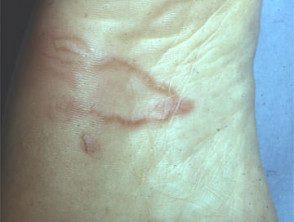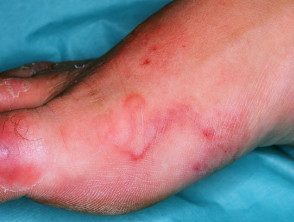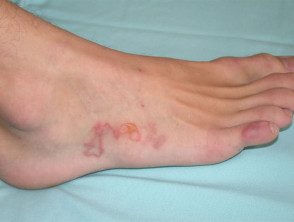What is it cutaneous larva migrans?
Cutaneous larva migrans is a parasitic skin. infection caused by hookworm larvae that generally infest cats, dogs and other animals. Humans can become infected with the larvae by walking barefoot on sandy beaches or by contacting soft, moist soil that has been contaminated with animal feces. Also known as creeping eruption Once infected, the larvae migrate beneath the surface of the skin and cause itchy red lines or footprints.
The migratory swellings known as larva migransdeep are described on the DermNet page on gnathostomiasis.
Cutaneous larva migrans

Cutaneous larva migrans

Cutaneous larva migrans

Cutaneous larva migrans
What causes cutaneous larva migrans?
Many types of hookworms can cause cutaneous larva migrans. Common causes are:
- Ancylostoma braziliense: hookworm of wild and domestic dogs and cats found in the central and southern US, Central and South America, and the Caribbean
- Ancylostoma caninum: canine hookworm found in Australia
- Uncinaria stenocephala: canine hookworm found in Europe
- Bunostomum phlebotomum: bovine hookworm
Who is at risk for cutaneous larva migrans?
People of all ages, sex and the breed may be affected by cutaneous larvae if they have been exposed to hookworm larvae. It is most commonly found in tropical or subtropical geographic locations. At-risk groups include those with occupations or hobbies that put them in contact with warm, wet, sandy soils. These may include:
- Barefoot beachcombers and sunbathers
- Children in sandboxes
- Farmers
- Gardeners
- Plumbers
- Hunters
- Electricians
- Carpenters
- Pest exterminators.
Most larvae seen in New Zealand emerge during holidays abroad, but have rarely been reported in those who have never been out of the country.
How does hookworm infection occur?
Parasite eggs are passed in the feces of infested animals to warm, moist, sandy soil, where the larvae hatch. In contact with human skin, the larvae can penetrate hair follicles, cracks or even intact skin to infect humans host. Within a few days to a few months after initial infection, the larvae migrate under the skin. In an animal host, the larvae can penetrate the deeper layers of the skin (the dermis) and infect the blood and lymphatic system. Once in the intestine, they mature sexually to create more eggs which are then excreted to begin the cycle again.
However, in a human host, the larvae are rarely able to penetrate the basement membrane to invade the dermis, so the disease generally remains confined to the outer layers of the skin. See larva migrans pathology.
What are the signs and symptoms of cutaneous larva migrans?
A non-specific rash occurs at the site of penetration of hookworm larvae. There may be a tingling or itching sensation within 30 minutes of larvae penetration. Larvae may remain dormant for weeks or months or immediately begin crawling activity that creates 2–3 mm wide snake tracks extending 3–4 cm from the penetration site. These are slightly raised, flesh-colored or pink, and cause intense itching. The tracks advance a few millimeters to a few centimeters a day and if many larvae are involved, a disorganized series of loops and tortuous tracks can form.
The most commonly affected sites by cutaneous larva migrans are the feet, spaces between the fingers, hands, knees and buttocks.
What treatment is available for cutaneous larva migrans?
Cutaneous larva migrans is self-limiting. Humans are an accidental, 'dead-end' host, so hookworm larvae eventually die. The natural duration of the disease varies considerably depending on the species of larvae involved. In most cases, lesions will resolve without treatment within 4 to 8 weeks.
However, there is an effective treatment to shorten the course of the disease.
- Anthelmintics such as thiabendazole, albendazole, mebendazole and ivermectin are used. Current Thiabendazole is considered the treatment of choice for the beginning, located Lesions Oral treatment is administered when cutaneous larva migrans is extended or topical treatment has failed. Itching is greatly reduced within 24-48 hours of starting anthelmintic treatment and within 1 week most lesions/tracts resolve.
- If not available, physical treatments such as liquid nitrogen cryotherapy or carbon dioxide To be can be used to destroy larvae.
-
Topical antihistamines and corticosteroids can also be used with anthelmintics to provide symptomatic relief from itch.
- Secondary bacterial The infection may require treatment with appropriate antibiotics.

